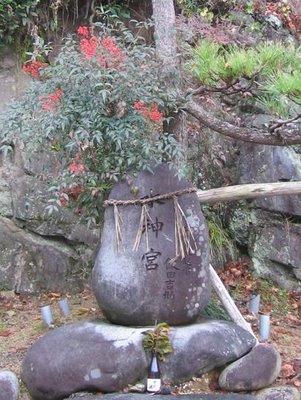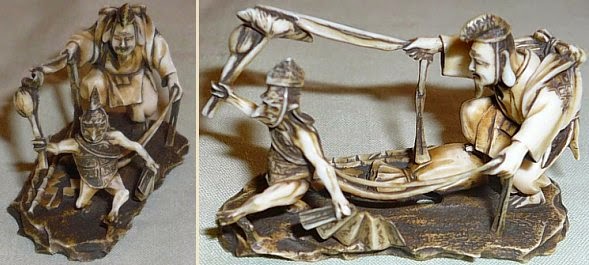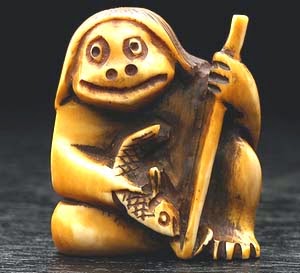:::::::::::::::::::::::::::::::::::::::::::::::::::::::::::::::::::::::::::::::::::::::::::::::::::::::::::::::::::::::::::::::::::::::::::::::::::::::::::::::::::::::::::::::::::
- KAPPA - 河童 / 合羽 / かっぱ / カッパ - ABC-Index -
:::::::::::::::::::::::::::::::::::::::::::::::::::::::::::::::::::::::::::::::::::::::::::::::::::::::::::::::::::::::::::::::::::::::::::::::::::::::::::::::::::::::::::::::::::
- suijin 水神 water deity -
God of Water, Mizu no Kamisama 水の神様
 Kappa Jinja 河童神社 Kappa Shinto Shrines
Kappa Daimyoojin 河童大明神 Kappa Daimyojin, Great Kappa Deity
Kappa Jinja 河童神社 Kappa Shinto Shrines
Kappa Daimyoojin 河童大明神 Kappa Daimyojin, Great Kappa Deity
Kappa Myoojin カッパ明神 Kappa Myojin
. Aragoroo Daimyoojin 荒五郎大明神 Aragoro Daimyojin .
- - - - - in - Tanushimaru 田主丸 Fukuoka, Kyushu -
. Fuku-Taroo 福太郎 Fukutaro - The Lucky Kappa .
Suitenguu 水天宮 Suitengu Shrine of the Water God
東京都中央区日本橋蛎殻町二丁目4番1号 Tokyo
. hyoozu no kami, Hyōzu 兵主神 Hyozu no Kami
- Deity of Wind and Weapons - .
Anashinimasu Hyozu jinja 穴師坐兵主神社 Hyogo
Egara Tenjin 荏柄天神 Kamakura, Kagawa
Itate Hyozu Jinja 射楯兵主神社 Hyogo
Oshiko Jinja 生石神社 Hyogo
Suitengu 水天宮
The main Suitengu Shrine of Japan, in 福岡 Fukuoka, Kyushu.
Suijin Jinja 水神神社, Nagasaki 長崎市本河内町 and the
. Kappa ishi 河童石 Kappa stone .
. Kappadoo 河童堂 Kappa-Do Hall - Gifu .
with 河童大明神 Kappa Daimyojin
. Kappa Jinja 河童神社 Isora Jinja 磯良神社 Miyagi .
. Kagoshima 鹿児島県 Kappa and 山の神 Yamanokami .
- - - - - Another water deity is
. Ryuujin 龍神 / 竜神 Ryujin, the Dragon Deity .
There are many amulets and talismans related to him.
. Amulets and talismans of the Dragon Deity .
:::::::::::::::::::::::::::::::::::::::::::::::::::::::::::::::::::::::::::::::::::::::::::::::::::::::::::::::::::::::::::::::::::::::::::::::::::::::::::::::::::::::::::::::::::
Most festivals for the Kappe Deity are performed in the sixth lunar month (even now in June). Fresh cucumbers are offered at the Kappa shrines.
九千坊河童 Kyusenbo kappa - Kusenbo Kappa, a warrior clan coming all the way from China to Kyushu to become a deity in
. - Tanushimaru 田主丸 Fukuoka - .
..............................................................................................................................................
- quote
KAPPA 河童 and SUIJIN 水神
The Kappa is one of many Suijin 水神 (water kami, water deities) in Japanese mythology.
Suijin are supernatural beings found in lakes, ponds, springs, wells, and irrigation waterways. They are often depicted as a snake, a dragon, an eel, a fish, a turtle, or a kappa. Many trace their origins back to earlier Chinese mythology, although Japan’s Kappa lore is largely indigenous.
The Suijin commonly possess magical powers, which can be used for either benevolent or malevolent purposes. For instance, the flesh-eating Kappa is mostly evil, but when captured, it will pledge to assist with farm work or to teach its captor the arts of setting bones and making medicines and salves.
One of the most curious Suijin in Japan manifests itself as the water-cleansing bacteria in sewage water (see
Gabi Greve Mizu no Kamisama).
According to the Institute for Japanese Culture & Classics (Kokugakuin University) , women have played an important role in the history of Suijin worship in Japan. However, with the great influx of Korean and Chinese people into Japan starting around the 2nd century AD, and with the subsequent introduction of Buddhism in the 6th century, Japan’s many indigenous water kami began to slowly absorb attributes from these emigrants and from Buddhism. Not surprisingly, this ongoing mixture of traditions makes it difficult to identify the origins of these “syncretic” deities. This difficulty is compounded by the lack of Shintō artwork or written records prior to the 8th century. The most powerful, universal, and benevolent Suijin in Japan is known as Mizu no Kamisama 水の神様 (Goddess/God of Water).
The Kappa, however, is more accurately described as the
Kawa no Kami 川の神 (River Deity), a term mentioned in the Nihon Shoki 日本書紀 (Chronicles of Japan), one of Japan's earliest official records, compiled around 720 AD. Some believe the Kappa, who didn’t appear as a popular icon until much later in the Edo Period (1615-1868), is none other than the river deity Kawa no Kami.
Please see the Suijin Page for details on Japan’s Suijin traditions.
- Shintō Mythology
Some believe the Kappa is the
“Kawa no Kami” 川の神 (lit. River Deity) mentioned in the Nihon Shoki 日本書紀 (Chronicles of Japan), one of Japan's earliest official records, compiled around 720 AD. Despite the Kappa’s seemingly ancient origin, the creature does not appear (to my knowledge) in texts and artwork of the medieval period.
In fact, the earliest illustration of the Kappa comes from the
Wakan Sansaizue 和漢三才図会, a 105-volume encyclopedia complied around 1713.

Another image appeared in the illustrated four-volume
Gazu Hyakkiyagyō 画図百鬼夜行 (Night Procession of One Hundred Demons). Kappa lore gained steadily in popularity throughout the Edo Period (1615-1868). We find mention of Kawatarō (Kawataro) 河太郎 in a serial called Kasshiyawa 甲子夜話, first appearing in 1821 and running until the death of the author in 1841.
We also find mention of the Kappa in the mid-Edo period document named Mimibukuro 耳嚢 (or 耳袋), a 10-volume document written by Negishi Yasumori 根岸鎮衛 (1737-1815). Translated in English as “Bag of Ears,” it is a collection of essays about then-prevailing religious and cultural beliefs.
- source : Mark Schumacher
:::::::::::::::::::::::::::::::::::::::::::::::::::::::::::::::::::::::::::::::::::::::::::::::::::::::::::::::::::::::::::::::::::::::::::::::::::::::::::::::::::::::::::::::::::
Kappa Jinja 河童神社 Kappa Shinto Shrines - ABC
..............................................................................................................................................
Fujisaki Jinja 藤崎神社
福岡市西新町 - Kyushu, Fukuoka
その年の初庚申の日を祭日とし、小さい猿の面を頒ち、門口に吊して魔除けと盗難除けにする。 少し昔、猿曳が川辺を通るとき、猿に目隠しをするのを見掛けたという。それは、人に見えぬが、猿には河童が見え、河童を見つけると捕らえねば承知しないという話による。
- source : www.ishinotent.co.jp
九州の河童 - Kappa in Kyushu - see
Tanushimaru above
天疫神社 Teneki Jinja / Tenyaku Jinja / Ten'eki Jinja
総元締を海御前といい、これを祀った福岡県北九州市門司区大積の天疫神社が元祖である。 海御前は、壇の浦の戦に敗れて入水した能登守教経の奥方が神になったと言い伝え、河童が端午の節句から出遊とるとき、一同を集め、「汝らは平家の族党なるゆえ、蕎麦の花が咲き出せば、源軍押し寄せたと思い、ただちに山へ引き上げよ」と厳命されていたので、彼等は初秋蕎麦の花が咲き出すと山に帰るという。
.
海御前様 Amagozensama, Ama Gozen .
大積の天疫神社は、平家の大将能登守教経の奥方が壇ノ浦の戦いのときに波間に投じ、ここの海場に流れ着いたのを里人が祀ったという。この女が神となって、海御前様と呼ばれ河童の総元締めになった。5月節句に河童を集めて、「蕎麦の花の咲かぬうちにもどれ(蕎麦の花は源氏の白旗のように白いので)、敵方にあらざる人畜の命は無暗にとってはならぬ」と厳命して解散するという。それから彼らは思い思いに遊びまわり、秋口蕎麦の花の咲くころに山に引き上げるのだという。
天疫神社 Teneki Jinja / Tenyaku Jinja / Ten'eki Jinja
It was founded around 900 when a pestilence and illness during a drought were killing many.
The shrine was built with the help of the villagers on top of Mount Takatsuki 高杯山 - and indeed, the pestilence subsided.

The shrine soon became famous in all of Northern Kyushu.
In the year 1632, when the Daimyo of the 小笠原 Ogasawara clan became regent, he had the shrine repaired and venerated again.
北九州市八幡東区宮の町2-2-1 / Miyanomachi, Yahatahigashi Ward, Kitakyushu
- reference : kcta.or.jp/kaidou/jinzya -
..............................................................................................................................................
Hashirimizu Jinja 走水神社 - Yokosuka 横須賀市
Kanagawa

..............................................................................................................................................
Hookura 方倉(宝倉)神社 / Hokura Suitengu、Hokura Jinja / Itsuki Island 生月島
Hookura Suitenguu 方倉水天宮
Hokura Suitengu

This unusual shrine is on the island of
Ikitsuki near Hirado, Kyushu.
Named Hokura Suitengu, it has strong kappa associations.
According to local tradition, the small pond was build by 99 kappa from a mixture of sea and mountain water, and to secure it from storms they built up the sides with rocks. Later the kappa morphed into a large
unagi eel (「神うなぎ」) which is treated as divine. If locals spot it when coming to worship, they feel they will be specially blessed...
. Dougill John on facebook .
- quote
Hookura 祠(ホクラ=宝倉、秀倉) "Treasure shrine" and the kappa is
Hookura sama 「ホウクラ様」 Hokura sama.
人間と出合うとすぐに相撲をとりたがるといわれる河童にあやかり、祈願成就には九99番(回)の相撲取組を奉納する習慣がある。
- source : nagasaki/kappa/houkura
..............................................................................................................................................
. Tetsugi Jinja 手接神社 Ibaraki .
茨城県小美玉市世沢 - with a Kappa legend
:::::::::::::::::::::::::::::::::::::::::::::::::::::::::::::::::::::::::::::::::::::::::::::::::::::::::::::::::::::::::::::::::::::::::::::::::::::::::::::::::::::::::::::::::::
Kawako no Miya 河伯の宮 "Shrine for Earl Kappa"
Shimane,
Matsue 松江 / 河内村 Kawachimura
Glimpses of Unfamiliar Japan, Volume 2 - By
Lafcadio Hearn
Nor are the dead the only invisible powers which are dreaded at the time of the Hotoke-umi. There are the most powerful ma and the kappa. At all times the swimmer fears the kappa, the
Ape of the Waters, hideous and obscene, who reaches up from the depths to draw men down and to devour their entrails. Only their entrails.
 - shared by Hayato san -
- Author’s Footnote:
- shared by Hayato san -
- Author’s Footnote:
The kappa is not really a sea goblin, but a river goblin, and haunts the sea only in the area of the mouths of rivers.
About a mile and a half from Matsue, at the little village of Kawachimura, on the river called Kawachi, stands a little temple called
Kawako-no-miya, or the Miya of the Kappa.
(In Izumo, among the common people, the word kappa is not used, but the term
kawako, or “The Child of the River.”)
A document said to have been signed by a kappa is preserved in this little shrine. The story goes that in ancient times, the kappa living in the Kawachi used to seize and destroy many of the inhabitants of the village and many domestic animals. One day, however, while trying to seize a horse that had entered the river to drink, the kappa got its head twisted in some way under the belly-band of the horse, and the terrified animal, rushing out of the water, dragged the kappa into a field. There, the owner of the horse and a number of peasants seized and bound the kappa.
All the villagers gathered to see the monster, which bowed its head to the ground and audibly begged for mercy.
The peasants wanted to kill the goblin at once; however, the owner of the horse, who happened to be the head man of the mura (village), said, “It is better to make it swear never again to touch any person or animal belonging to Kawachimura.” A written form of oath was prepared and read to the kappa. It said that it could not write, but that it would sign the paper by dipping its hand in ink, and pressing the imprint at the bottom of the document. This having been agreed to and done, the kappa was set free. From that time forward, no inhabitant or animal of Kawachimura was ever assaulted by the goblin.
source : books.google.co.jp
. kahaku, kawa no kami 河伯(かわのかみ) River Deity, "river chief" .
originally a Chinese river deity with a demon-like face.
Sometimes his face is part of a "demon tile" onigawara 鬼瓦 to protect a building from fire.
In Japan, another name for the water goblin Kappa.
Kahaku Shushin 河伯主神 Kahaku Water Deity
安福河伯神社 Abuku Kahaku Jinja / Afuku Kahaku-jinja
宮城県亘理郡亘理町逢隈田沢字堰下220 / Miyagi
- reference -
. - KAPPA - 河童 - Legends from Miyagi 宮城県 .
:::::::::::::::::::::::::::::::::::::::::::::::::::::::::::::::::::::::::::::::::::::::::::::::::::::::::::::::::::::::::::::::::::::::::::::::::::::::::::::::::::::::::::::::::::
Matsubara Kappa Sha 松原河童社
at Saga Jinja 佐嘉神社, Saga, Kyushu 佐賀
with amulets to ward off evil and have good luck 開運厄除守



佐賀県佐賀市松原2丁目10 松原河童社
- source : matome.naver.jp/odai
. Hyoosube ひょうすべ Hyosube .
Saga prefecture 佐賀県
..............................................................................................................................................
. Hyozu Shrines 兵主神社 Hyozu Jinja in Japan .
They are all famous for their power to prevent evil from a Kappa 河童除け (kappa yoke, kappayoke).
. yakuyoke 厄除け amulets to ward off evil .
- kappa yoke, kappayoke 河童除け to ward off the evil influence of a kappa, especially water accidents.
mizuyoke 水難除け amulets to ward off water accidents
They are also sold at temples.
聖徳寺 Shotoku-Ji, Kumamoto 熊本市
A temple with a Kappa legend.
河童が馬にイタズラをしたと伝わるのが、聖徳寺さんから少し離れた所にある川の側にあります、高橋東神社の境内に今も残る巨大な楠木。
ここにつながれていた馬に、河童がちょっかいを出して聖徳寺まで引きずられてきたわけです。

かつては川に入る子供達はこの水難除けの御札を小さな竹筒に入れて肩からかけていたとの事でしたが、最近では川に入って泳ぐという事自体が少なくなって来たので、この御札の活躍の場も無くなって来たというお話でした。
- source : sakuragaoka - syoutoku
..............................................................................................................................................
Kitano Tenmangu - Fukuoka 福岡県の北野天満宮
has a mummy of the arm of Kappa -
kahaku no te 河伯の手 / kappa no te 河童の手
In the year 901, when Michizane was about to be murdered at the 筑後川 Chikugogawa river, the general of the regional Kappa 河童の大将 streched out his arm to help him, but his hand was cut off.
 source : daizukan9.blog63.fc2.com
source : daizukan9.blog63.fc2.com
Or maybe the Kappa had come out to pull his horse into the water and Michizane himself cut off his arm.
. Sugawara Michizane 菅原道真 .
- and the 天満宮 Tenmangu shrines of Japan
. - mummy - miira 河童のミイラ mummy of a Kappa, Mumie - .
. Chikugo no kuni 筑後国 Chikugo Province Kappa Legends . Kyushu
..............................................................................................................................................
Kappabuchi Jinja 河原淵神社 Shrine Kappabuchi
伊勢神宮豊受大神宮(外宮)の摂社
Mie, Ise Jingu 三重県伊勢市船江一丁目
old name is
Funaekami no yashiro 船江上社(ふなえかみのやしろ)
- - - More in the WIKIPEDIA !
. - Kappabuchi, Kappa-buchi 河童淵 / カッパ淵 / 河童が渕
"Kappa river pool", Kappa riverside - .
tba
:::::::::::::::::::::::::::::::::::::::::::::::::::::::::::::::::::::::::::::::::::::::::::::::::::::::::::::::::::::::::::::::::::::::::::::::::::::::::::::::::::::::::::::::::::
- quote -
The Mysterious Kappa Shrine
The shrine was inside of what seemed like three huge boulders placed together to form a cave.

Inside the cave was a statue of a male and female Kappa. The male was holding his willy while the female looked on in a seated position. They both have a wide eyed blank gaze that was weirdly disturbing. Almost as if the minute you walked into the shrine you stumbled upon the two just finishing up some sexcapade and they got scared and turned to stone.
- source : www.great-sensei.com
:::::::::::::::::::::::::::::::::::::::::::::::::::::::::::::::::::::::::::::::::::::::::::::::::::::::::::::::::::::::::::::::::::::::::::::::::::::::::::::::::::::::::::::::::::
- reference - kappa river deity -
- reference - kappa water god -
. - benevolent Kappa 慈善河童 jizen no Kappa - .
. daija, orochi 大蛇 the huge serpent, great snake .
. komainu, Kappa koma-inu カッパ狛犬 / 河童狛犬 Kappa as Komainu .
. Legends about the Kappa .
. - Otter 獺魚 kawauso as kappa deities - .
 . God of Water, Mizu no Kamisama 水の神様 .
- Introduction -
. God of Water, Mizu no Kamisama 水の神様 .
- Introduction -
:::::::::::::::::::::::::::::::::::::::::::::::::::::::::::::::::::::::::::::::::::::::::::::::::::::::::::::::::::::::::::::::::::::::::::::::::::::::::::::::::::::::::::::::::::
 . - - - Join my Kappa friends on facebook ! - - - .
. - - - Join my Kappa friends on facebook ! - - - .
:::::::::::::::::::::::::::::::::::::::::::::::::::::::::::::::::::::::::::::::::::::::::::::::::::::::::::::::::::::::::::::::::::::::::::::::::::::::::::::::::::::::::::::::::::
. Mingei 民芸 Regional Folk Art from Japan .
. Jinja 神社 Shinto Shrines of Japan - ABC-List .
. Suijin sawari 水神ざわり Taboos for the Deity of Water .
- #kappashrines #shrines -
:::::::::::::::::::::::::::::::::::::::::::::::::::::::::::::::::::::::::::::::::::::::::::::::::::::::::::::::::::::::::::::::::::::::::::::::::::::::::::::::::::::::::::::::::::
[ . BACK to DARUMA MUSEUM TOP . ]
[ . BACK to WORLDKIGO . TOP . ]
:::::::::::::::::::::::::::::::::::::::::::::::::::::::::::::::::::::::::::::::::::::::::::::::::::::::::::::::::::::::::::::::::::::::::::::::::::::::::::::::::::::::::::::::::::















































